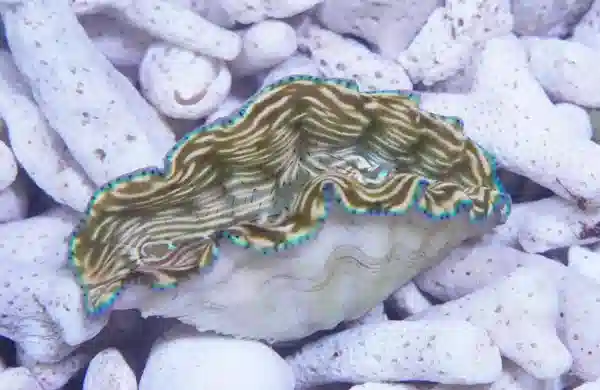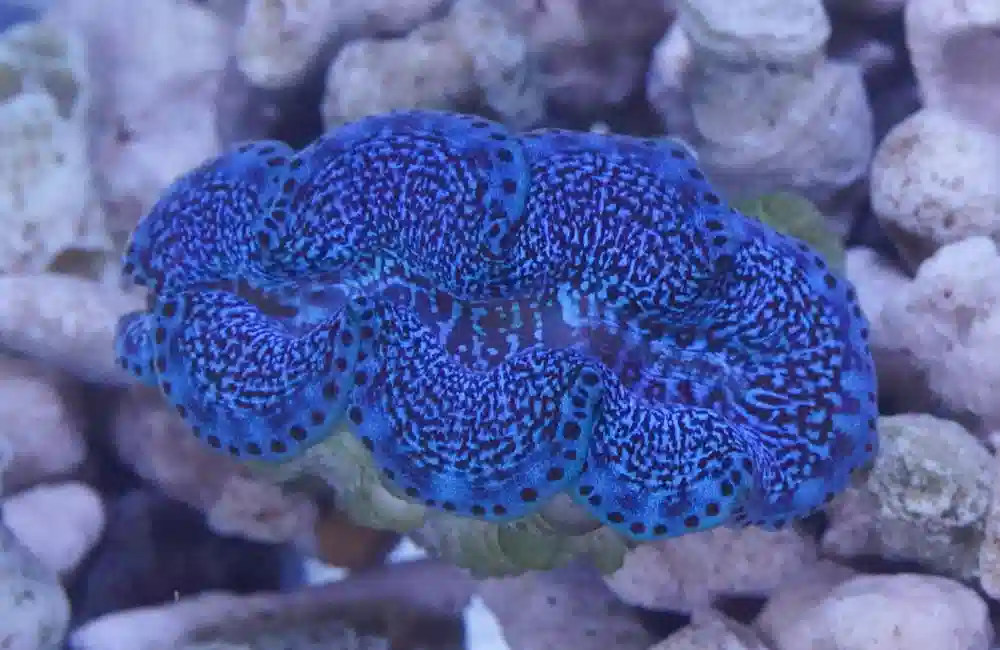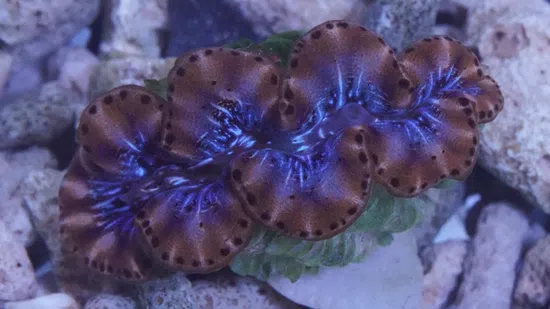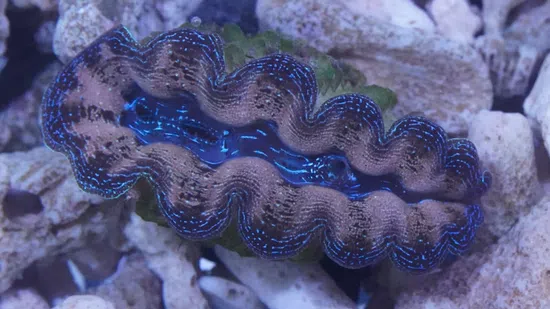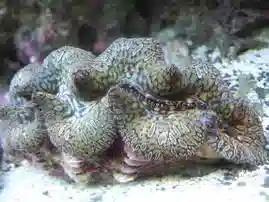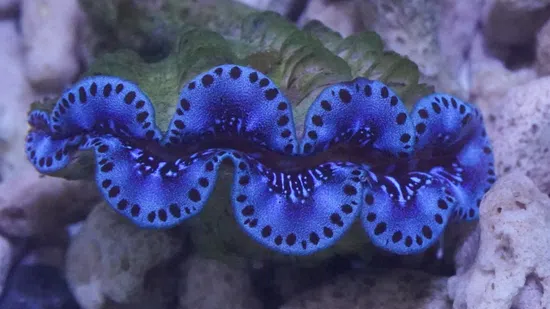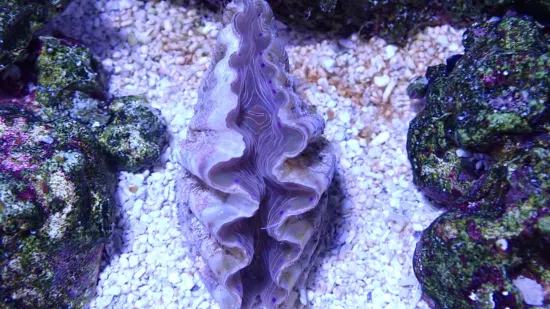Clams In Saltwater Aquariums: FAQ
Yes, you can absolutely keep clams in a saltwater aquarium, and they can become stunning, functional centerpieces in a thriving reef setup. Marine clams, especially Tridacna species (often called giant clams), are both beautiful and beneficial, they naturally filter the water, remove excess nutrients, and add a vibrant, natural touch to reef aquascapes. However, they do require strong lighting, stable water conditions, and moderate tank maturity to thrive long-term.
Why clams are great for reef tanks:
Natural filtration: Clams filter microscopic particles and nitrates from the water, helping improve clarity and nutrient balance.
Aesthetic appeal: Species like the *Maxima Clam (Tridacna maxima) and Crocea Clam (Tridacna crocea) display iridescent blues, purples, and greens under reef lighting.
Reef-safe and peaceful: They don’t harm corals or fish and can coexist with most peaceful tankmates.
Indicator of water quality: Clams respond quickly to changes in lighting or chemistry, often serving as natural “health gauges” for your reef system.
Essential care requirements:
Lighting: High-intensity reef lighting (T5, metal halide, or LED with PAR 250–400) is critical, as clams rely heavily on symbiotic algae (zooxanthellae) for energy.
Water parameters: Keep calcium at 400–450 ppm, alkalinity between 8–12 dKH, magnesium at 1250–1350 ppm, and salinity at 1.024–1.026.
Tank maturity: Clams do best in established systems (6+ months old) with stable parameters.
Placement: Set clams on rockwork or substrate depending on species, Crocea prefers rock; Derasa and Squamosa prefer sand.
One Saltwaterfish.com reviewer of the Fiji Ultra Crocea Clam shared: “My wife loves this little thing\! It’s so beautiful. Wide open on the rocks towards the top of the tank. It made itself right at home. Looks blue from the side but a great turquoise color when viewed from above.”
Pro care tips:
Avoid copper and metal-based medications, lethal to clams.
Maintain consistent temperature (75–78°F) and avoid salinity swings.
Supplement phytoplankton for young clams under 3 inches, they need extra nutrition.
- Watch for pyramid snails (tiny parasites) and gently remove if found.
Bottom line:
Yes, clams can be beautiful and beneficial additions to saltwater aquariums when provided with stable water, strong lighting, and consistent care. Their vibrant mantles and natural filtration abilities make them a rewarding choice for intermediate to advanced reef keepers. For healthy, sustainably sourced species like the Maxima and Crocea Clam, explore Saltwaterfish.com’s live clam collection, all backed by our 8-Day Live Guarantee for confident, reef-safe success.
The best clams for saltwater aquariums are members of the Tridacna genus, often called giant clams. These reef-safe, photosynthetic mollusks are prized for their vibrant colors, natural filtration abilities, and compatibility with reef systems. The key is matching the species to your tank’s lighting, depth, and experience level, some clams thrive in beginner systems, while others demand advanced reef conditions.
Top Tridacna clams for aquariums:
1. *Maxima Clam (Tridacna maxima)
Most popular and colorful species
Brilliant blue, green, and gold mantle patterns that shimmer under LED or T5 lighting.
Requires high-intensity lighting (PAR 300+) and stable calcium (400–450 ppm).
Ideal for experienced reef keepers with strong lighting and excellent water stability.
2. Crocea Clam (Tridacna crocea)
Smallest and most compact giant clam (typically 4–6 inches).
Prefers to attach to live rock with a strong foot; perfect for mid-to-upper tank placement.
Thrives under bright lighting and pristine water, best for intermediate aquarists.
3. *Derasa Clam (Tridacna derasa)
Best clam for beginners
Hardy, fast-growing, and tolerant of moderate lighting (PAR 200–250).
Peaceful and adaptable, suitable for placement on sand or rock at the bottom of the tank.
4. *Squamosa Clam (Tridacna squamosa)
Excellent for larger aquariums
Distinctive fluted shell and tan, gold, or green mantle patterns.
Grows up to 12 inches; needs stable calcium and alkalinity for healthy shell development.
Why Tridacna clams are ideal for reef aquariums:
Reef-safe: They won’t harm corals or fish.
Natural filters: Each clam filters several liters of water per hour, improving clarity.
Visually stunning: Their iridescent mantles react beautifully to reef lighting.
Long-lived: Can thrive for over a decade in stable aquariums.
One Saltwaterfish.com reviewer of the Squamosa Clam shared: “This clam is opening up beautifully\!\! Great addition for any reef tank.”
Pro selection tips:
For beginners: choose Derasa or Squamosa clams.
For advanced setups: Crocea and Maxima deliver unparalleled color and vibrancy.
Maintain calcium (400–450 ppm), alkalinity (8–12 dKH), and magnesium (1250–1350 ppm).
Avoid copper and rapid salinity changes, both can be fatal.
Bottom line:
The best clams for saltwater aquariums are Tridacna species, especially Maxima, Crocea, Derasa, and Squamosa clams. They’re colorful, reef-safe, and naturally beneficial to water quality when kept under strong lighting and stable conditions. To find healthy, sustainably sourced clams backed by our 8-Day Live Guarantee, explore Saltwaterfish.com’s live clam collection, trusted by aquarists for quality and care since 1999\.
Clams can be an excellent addition to reef aquariums, but they’re generally best suited for intermediate hobbyists rather than complete beginners. These beautiful filter feeders, particularly the Tridacna species, rely on a stable environment with consistent lighting, calcium, and nutrient levels. While they’re hardy once settled, even small fluctuations in water chemistry can stress or kill them. However, with patience and proper preparation, beginning reef keepers can successfully keep the hardier clam species like Tridacna derasa or Tridacna squamosa.
Why clams can be challenging for beginners:
Lighting sensitivity: Most clams depend heavily on strong reef lighting to feed their symbiotic algae (zooxanthellae). Weak or unstable lighting leads to bleaching or starvation.
Calcium and alkalinity demands: Clams grow thick calcium carbonate shells, requiring high and stable calcium (400–450 ppm) and alkalinity (8–12 dKH).
Tank maturity: New systems can have nutrient swings and trace metal imbalances that stress filter-feeding invertebrates.
Copper sensitivity: Even trace amounts of copper (from tap water or medications) can be fatal.
Best clams for beginners:
Derasa Clam (Tridacna derasa) – Hardy, adaptable, and tolerant of moderate lighting; grows quickly and thrives on sandbeds.
*Squamosa Clam (Tridacna squamosa) – Beautiful and durable; does well in larger tanks with stable water parameters.
Species to save for later:
*Maxima Clam (Tridacna maxima) and Crocea Clam (Tridacna crocea) – Stunning colors but require intense lighting (PAR 300+) and mature, ultra-stable reef systems.
One Saltwaterfish.com reviewer of the 1st Grade Crocea Clam shared: “Very beautiful clam. It's very small, but the exact size as listed. The description is it's length, not width.”
Pro tips for new reef keepers:
Start with a mature tank (6+ months old) to ensure stable chemistry.
Maintain consistent water changes to replenish trace minerals.
Test calcium, alkalinity, and magnesium weekly.
- Provide moderate lighting (T5 or LED) and avoid placing clams in strong current zones.
Bottom line:
Clams can absolutely thrive in home aquariums, but for beginners, choose hardy species like Derasa or Squamosa, and introduce them only once your reef has matured and stabilized. With consistent care, they’ll reward you with brilliant color and natural filtration for years. Explore Saltwaterfish.com’s live clam collection for beginner-friendly, sustainably sourced clams, all backed by our 8-Day Live Guarantee for healthy, confident reefkeeping.
Most healthy saltwater clams don’t need direct feeding once they’re established in a well-lit, mature reef tank. The majority of clams sold for aquariums (especially Tridacna species such as Maxima, Crocea, Derasa, and Squamosa) derive most of their energy from photosynthesis via symbiotic algae (zooxanthellae) within their tissues. These algae convert light into energy, providing up to 90% of the clam’s nutritional needs when lighting is strong and stable.
However, juvenile or small clams under 3 inches may benefit from supplemental feeding because their mantle area is smaller, and they rely more heavily on filter feeding. These clams can absorb microscopic plankton and organic particles from the water column to support early shell growth and immune health.
When to feed your clam:
Small clams (\<3 inches): Feed live or refrigerated phytoplankton 2–3 times per week.
Large clams (\>3 inches): Rely primarily on strong reef lighting (T5, LED, or halide). Occasional phytoplankton feedings can still promote growth and color.
Tank setup: In well-stocked reef tanks, corals, copepods, and microalgae often generate enough natural plankton for adult clams to thrive without additional feeding.
How to feed safely:
Turn off protein skimmers for 30–60 minutes when feeding to allow phytoplankton suspension.
Use a turkey baster or pipette to gently disperse plankton near the clam’s intake siphon.
Avoid overfeeding, excess plankton can raise nitrates and reduce water quality.
Klumpp & Griffiths (1994) found that Tridacna species meet up to 90% of their carbon demand through photosynthesis, with filter feeding supplementing the rest. Juveniles, however, depend more heavily on suspended microalgae until their symbiont density and mantle size mature
One Saltwaterfish.com reviewer of the Gold Maxima Clam shared: “Beautiful clam with vibrant colors\!”
Pro feeding & lighting tips:
Provide PAR 250–400 lighting for Maxima and Crocea clams.
Ensure calcium (400–450 ppm) and alkalinity (8–12 dKH) for shell growth.
Avoid feeding with powders or artificial foods, only natural phytoplankton is suitable.
Keep water crystal clear to allow full light penetration to the clam’s mantle.
Bottom line:
Most saltwater clams don’t need manual feeding if they receive strong, stable lighting and clean, nutrient-balanced water. Smaller or newly added clams may benefit from phytoplankton supplements, but for mature systems, your reef’s light and natural plankton are usually enough. To find healthy, sustainably sourced clams like Maxima, Crocea, or Derasa, shop Saltwaterfish.com’s live clam collection, each backed by our 8-Day Live Guarantee for healthy, thriving arrivals.
Yes, saltwater clams are natural water filters, and they play an important role in maintaining water quality and clarity in reef aquariums. Marine clams, especially Tridacna species, are filter feeders that remove microscopic particles, plankton, and dissolved organic compounds from the water column as they breathe and feed. In doing so, they help stabilize nutrient levels, reduce algae-fueling waste, and support a more balanced reef ecosystem.
How clams clean aquarium water:
Filter feeding: Clams draw in water through an inhalant siphon, trapping suspended organic matter, phytoplankton, and bacteria before expelling clean water through an exhalant siphon.
Nutrient reduction: Each clam can filter gallons of water per hour, naturally reducing nitrates and phosphates that contribute to nuisance algae growth.
Water clarity: Continuous filtration helps keep your aquarium visibly clearer and more stable between water changes.
Support for other reef life: By lowering nutrient levels, clams create a cleaner environment for corals, anemones, and sensitive invertebrates.
Best clams for water filtration:
Derasa Clam (Tridacna derasa) – Hardy and fast-growing; excellent natural filter for larger systems.
*Squamosa Clam (Tridacna squamosa) – Effective at filtering suspended organics; great for mature reefs.
*Maxima Clam (Tridacna maxima) – Offers both beauty and filtration power in brightly lit tanks.
Klumpp & Lucas (1992) measured Tridacna derasa filtering up to 10 L of seawater per hour, significantly reducing particulate loads.
One Saltwaterfish.com reviewer of the Fiji Maxima Clam shared: “This guy moves around a little bit. I am hoping it will find a good location to show off its colors.”
Pro reefkeeping tips:
Clams are supplements to your filtration, not replacements for mechanical or biological filters.
Place clams in areas with moderate flow to deliver a steady supply of plankton and oxygen.
Keep water parameters stable: salinity (1.024–1.026), calcium (400–450 ppm), and alkalinity (8–12 dKH).
- Avoid copper-based medications or contaminants, they can harm or kill filter-feeding invertebrates.
Bottom line:
Yes, clams help clean and stabilize reef aquarium water naturally by filtering organic waste and excess nutrients. Their constant filtration improves water clarity, supports coral health, and enhances your tank’s overall balance. For beautiful, reef-safe species like the Derasa, Squamosa, and Maxima Clam, explore Saltwaterfish.com’s live clam collection, all backed by our 8-Day Live Guarantee for healthy, effective natural filtration you can trust.
All members of the Tridacna genus are reef safe and make exceptional additions to coral reef aquariums. These clams live symbiotically with photosynthetic algae (zooxanthellae), contributing to reef health rather than harming it. Unlike predatory clams or bivalves that can burrow or disturb substrate, Tridacna clams are completely peaceful, they won’t sting, nip, or compete with corals or fish. Their constant filtration actually improves reef water quality, making them one of the most beneficial invertebrates for balanced, long-term ecosystems.
Reef-safe clam species to consider:
1. *Hippopus Clam (Hippopus hippopus)
Distinctive tan and cream mantle with striking ridged shells.
Very hardy and tolerant of moderate light levels (PAR 150–250).
Grows large, best for tanks 75+ gallons.
2. *Teardrop Maxima Clam (Tridacna maxima var. teardrop)
A rare variant of T. maxima featuring golden or blue “teardrop” mantle spots.
Completely reef safe and visually stunning under blue reef LEDs.
Requires strong lighting and pristine water, ideal for experienced reef keepers.
3. *Gold-lipped Derasa Clam (Tridacna derasa var. gold)
Hardy beginner-friendly variety with a warm bronze-gold hue and thick shell ridges.
Peaceful and non-invasive; great for sandbed placement.
4. Blue Squamosina Clam (Tridacna squamosina)
Rare and newly rediscovered species from the Red Sea.
Reef-safe and non-aggressive, thriving under high-intensity lighting.
Beautiful blue-green mantle with delicate patterns, ideal showpiece for large reefs.
5. *Bear Paw Clam (Hippopus porcellanus)
Thick-shelled, highly durable clam species often called “Porcelain Clam.”
Perfectly reef safe, with subtle marbled patterns and unique shell texture.
Best for larger aquariums due to its potential size (up to 12 inches).
*Why Tridacna and Hippopus species are reef safe:
Non-aggressive: They don’t release toxins or extend stinging tentacles.
Photosynthetic symbiosis: Their energy comes from light, not from consuming other tank inhabitants.
Water filtration: Each clam filters gallons of water daily, improving clarity and coral growth potential.
One Saltwaterfish.com reviewer of the Hippopus Clam shared: “Very nice clam\! Been in my tank for a month now. Doing very well.”
Pro reef tips for clam compatibility:
Avoid placement directly under aggressive LPS corals with long sweepers (torch, hammer).
Ensure high, stable calcium and alkalinity to support shell health.
Provide adequate lighting, reef-safe clams depend on photosynthesis.
Never expose clams to copper or rapid salinity changes.
Bottom line:
Reef-safe clams include Tridacna and Hippopus species, gentle, filter-feeding invertebrates that clean water, enhance coral health, and add brilliant natural color. From the hardy Gold-lipped Derasa to the exotic Blue Squamosina, these clams thrive peacefully in reef environments. Discover unique, sustainably sourced options in Saltwaterfish.com’s live clam collection, each backed by our 8-Day Live Guarantee for confident, reef-safe success.
Tridacna clams, often called “giant clams,” can grow impressively large in saltwater aquariums (depending on the species, lighting, diet, and available calcium.) In captivity, most Tridacna species reach between 6 and 12 inches, while larger species like Tridacna gigas can exceed 24 inches in the wild. Growth is slow and steady, usually around ½ inch per year once settled into a mature reef system with consistent water parameters.
Average adult sizes by species:
Tridacna maxima (Maxima Clam): 6–10 inches. Compact, colorful, and perfect for medium-sized reef aquariums.
Tridacna crocea (Crocea Clam): 4–6 inches. Smallest of the giant clams; attaches firmly to live rock.
Tridacna derasa (Derasa Clam): 10–16 inches. Grows rapidly and is one of the largest, hardiest aquarium clams.
Tridacna squamosa (Squamosa Clam): 10–12 inches. Develops fluted shell ridges; ideal for sandbed placement.
Tridacna gigas (Giant Clam): Up to 36–48 inches in the wild, though rare and impractical for most home aquariums.
Factors that influence growth:
Lighting: High PAR (250–400) allows the clam’s symbiotic zooxanthellae to photosynthesize efficiently, fueling shell growth.
Calcium and alkalinity: Maintain Ca 400–450 ppm and Alk 8–12 dKH to support steady shell development.
Tank maturity: Clams grow best in stable systems at least six months old with balanced nutrients.
Diet: Supplemental phytoplankton helps small clams (\<3") accelerate early growth stages.
One Saltwaterfish.com reviewer of the 1st Grade Turquoise Maxima Clam shared: “Exceeded expectations..twice the size I thought it would be\! Very happy.”
Pro reef tips for managing size:
Plan for space, Derasa and Squamosa clams need at least 75+ gallons as adults.
Place large clams on the sandbed to prevent shading corals.
Avoid frequent moving; clams attach to surfaces with strong byssal threads.
Supplement with iodine and trace minerals during regular water changes.
Bottom line:
Tridacna* clams typically grow 6–12 inches in reef tanks, though larger species can exceed a foot in spacious, well-lit systems. Their slow, graceful growth makes them both manageable and rewarding for long-term reef keepers. For healthy, sustainably sourced clams like the Maxima, Crocea, or Derasa, explore Saltwaterfish.com’s live clam collection, all backed by our 8-Day Live Guarantee for thriving, long-lived specimens.
Clams, especially Tridacna species, are among the longest-living invertebrates you can keep in a reef aquarium. In well-maintained tanks with stable lighting, water chemistry, and calcium levels, most clams can live 10 to 20 years, and some have been known to survive even longer. Their longevity is directly tied to tank stability, when water parameters remain consistent and the clam receives proper lighting and nutrition, it can thrive for decades.
Average lifespans by species:
Tridacna crocea (Crocea Clam): 8–10 years; compact, reef-safe, and long-lived under strong lighting.
Tridacna maxima (Maxima Clam): 10–15 years; a vibrant, hardy choice when calcium is well maintained.
Tridacna derasa (Derasa Clam): 15–20 years; one of the hardiest and longest-lived clams in captivity.
Tridacna squamosa (Squamosa Clam): 12–18 years; durable, with steady, manageable growth.
Tridacna gigas (Giant Clam): Can live 100+ years in the wild, though rarely kept long-term in home aquariums due to size.
Factors that affect lifespan:
Water stability: Maintain temperature (75–78°F), salinity (1.024–1.026), and pH (8.1–8.4) consistently.
Calcium and alkalinity: Keep calcium at 400–450 ppm and alkalinity between 8–12 dKH for strong shell formation.
Lighting: Provide high PAR reef lighting (250–400) to support the clam’s symbiotic zooxanthellae.
Nutrition: Feed small clams (\<3”) with live or refrigerated phytoplankton 2–3 times weekly; larger clams rely primarily on photosynthesis.
No copper: Even trace copper or heavy metals can quickly shorten lifespan.
One Saltwaterfish.com reviewer of the Fiji Ultra Crocea Clam shared: “Absolutely gorgeous \- brightly colored and was opened up "feeding" on his new home's light minutes after being added.”
Pro care tips for long-term success:
Perform regular water changes to replenish trace elements.
Avoid placing clams near aggressive corals or stinging invertebrates.
Provide enough space for future shell expansion.
Observe mantle behavior, tight closure or gaping may signal stress.
Bottom line:
With stable lighting, strong calcium support, and clean, toxin-free water, most Tridacna clams live 10–20 years or longer in home aquariums. Their longevity and natural filtration ability make them both stunning and sustainable additions to any reef system. For healthy, captive-conditioned clams like the Crocea, Maxima, or Derasa Clam, explore Saltwaterfish.com’s live clam collection, all backed by our 8-Day Live Guarantee for confident, long-term reefkeeping.
A healthy clam in a saltwater aquarium is active, responsive, and fully extended under proper lighting. Tridacna clams are living indicators of reef health, when water quality and lighting are ideal, they remain open, vibrant, and filter constantly. Subtle changes in their posture, color, or reaction to light can signal early stress, so observing them closely is key to long-term success.
Signs your clam is healthy:
Mantle fully extended: The fleshy, colorful mantle should spread wide and cover the shell edges during the day, showing iridescent color and smooth texture.
Strong light response: Healthy clams quickly retract their mantle when a shadow passes or when you wave your hand over them, this shows normal sensory function.
Firm shell closure: When touched or startled, the clam should close its shell rapidly and completely, a sign of strong muscles and good overall health.
Consistent attachment: Many clams, like Crocea and Maxima Clams, attach firmly to rock or substrate with byssal threads. A secure grip indicates contentment and proper placement.
Vibrant color: Bright blue, green, gold, or brown mantles reflect healthy zooxanthellae (the symbiotic algae that provide energy). Fading or bleaching often means inadequate lighting or stress.
Regular filtering: Slight opening and closing as the clam filters water is a positive sign, it’s constantly feeding and oxygenating.
Warning signs of stress or poor health:
Mantle gaping widely or staying withdrawn.
Dull or patchy coloration.
Slow, incomplete shell closure.
Detachment from substrate.
Snail infestation (e.g., pyramid snails) on the underside of the shell.
One Saltwaterfish.com reviewer of the Fiji Maxima Clam shared: “Beautiful healthy clam\! Was open as soon as it was in the tank.”
Pro tips for maintaining clam health:
Maintain calcium (400–450 ppm) and alkalinity (8–12 dKH) to support shell growth.
Provide strong reef lighting (PAR 250–400).
Keep salinity at 1.024–1.026 and temperature around 75–78°F.
Avoid copper and heavy metals, lethal to clams.
Regularly inspect for pyramid snails or other pests near the byssal opening.
Bottom line:
A healthy clam is open, colorful, responsive, and firmly attached, a living reflection of your tank’s stability. When provided strong light, balanced chemistry, and consistent care, Tridacna clams thrive for years as vibrant, reef-safe centerpiece species. For healthy, sustainably sourced clams like the Crocea, Maxima, or Derasa, explore Saltwaterfish.com’s live clam collection, each backed by our 8-Day Live Guarantee for thriving, reef-ready arrivals.
Before adding a clam to your reef aquarium, it’s important to understand that these beautiful filter feeders, especially Tridacna species, thrive only in mature, stable, and well-lit environments. Clams are sensitive to fluctuations in water chemistry, salinity, and lighting, but when properly introduced, they become both a striking visual centerpiece and a natural contributor to your tank’s filtration and balance.
Here’s what to know before bringing one home:
Tank maturity and stability
Only introduce clams into aquariums that have been running for at least 6 months with consistent parameters.
Avoid adding clams during the early stages of cycling or major equipment changes, fluctuating pH, calcium, or salinity can be fatal.
Lighting requirements
Clams rely on symbiotic algae (zooxanthellae) that need high-intensity reef lighting (PAR 250–400).
Maxima and Crocea Clams demand the brightest light and should be placed high on rockwork, while Derasa and Squamosa Clams tolerate moderate lighting on the sandbed.
Water chemistry
Keep calcium at 400–450 ppm, alkalinity 8–12 dKH, and magnesium 1250–1350 ppm for shell and mantle growth.
Maintain temperature between 75–78°F, salinity 1.024–1.026, and pH 8.1–8.4.
Clams are extremely sensitive to copper, formalin, and heavy metals, so avoid any medicated water or unfiltered tap water additions.
Placement and flow
Place clams on a stable surface: Crocea prefers live rock (it will attach using byssal threads), while Derasa and Squamosa prefer the sandbed.
Ensure moderate flow, enough to keep detritus from settling but gentle enough to avoid mantle irritation.
Feeding and nutrition
Small clams (\<3”) benefit from live or refrigerated phytoplankton 2–3 times weekly.
Larger clams rely mainly on light for nutrition but still filter-feed naturally from the water column.
Tankmates and protection
Avoid placing clams with predatory fish or invertebrates such as triggers, puffers, and large wrasses, which may nip at the mantle.
Inspect for pyramid snails before and after introduction, these tiny pests can damage the clam’s tissue and foot.
One Saltwaterfish.com reviewer of the Striped w/ Blue Rim Derasa Clam shared: “Small for now but it's color really shows. Can't wait to see it get bigger”
Pro acclimation tips:
Use a drip acclimation method over 45–60 minutes to avoid osmotic shock.
Keep clams submerged during transfers; never expose the byssal opening to air for long periods.
Dim your lights for the first few hours after introduction to reduce stress.
Bottom line:
Before adding a clam, ensure your reef tank is mature, well-lit, and chemically stable. Choose the right species for your lighting intensity and placement, and handle with care during acclimation. With the right preparation, clams can live for over a decade, filtering water, enriching your reef’s balance, and becoming one of its most rewarding centerpieces. For healthy, sustainably sourced options like the Derasa, Crocea, or Squamosa Clam, explore Saltwaterfish.com’s live clam collection, each backed by our 8-Day Live Guarantee for confident, reef-safe success.
Clams are sensitive invertebrates that must be acclimated slowly and carefully to ensure long-term success. Because they rely on both light and stable water chemistry for survival, the biggest threats during introduction are sudden changes in temperature, salinity, or lighting intensity. A proper acclimation routine allows your new clam to adjust gently, preventing stress, gaping, or bleaching.
Step-by-step guide to acclimating a new clam:
Float the sealed bag (15–20 minutes)
Upon arrival, place the sealed bag in your tank or sump to equalize temperature.
Keep it away from strong lighting or flow during this step to avoid heat stress.
Transfer the clam to a clean container
Gently open the bag and pour both the clam and shipping water into a separate bucket or specimen container.
Do not add shipping water to your display tank, it may contain waste or depleted oxygen.
Start a slow drip acclimation (45–60 minutes)
Use airline tubing or a drip line to slowly add your tank’s water to the container (2–4 drops per second).
When the volume doubles, discard half and continue dripping again until it doubles once more.
This gradual mix balances temperature, pH, and salinity, minimizing osmotic shock.
Check salinity and temperature before transferring
Ensure both match your display tank (salinity 1.024–1.026, temperature 75–78°F).
Gently place the clam in your tank
Always keep the clam submerged, never expose the byssal opening (foot) to air for long periods.
Place Crocea or Maxima clams on live rock, and Derasa or Squamosa clams on sandbeds for stability.
Dim lights for the first few hours
Gradually ramp up your reef lighting over 24–48 hours. Sudden bright exposure can bleach the clam’s symbiotic algae (zooxanthellae).
Avoid disturbance for several days
Don’t move or handle the clam once placed, it will naturally attach itself via byssal threads within a few days.
One Saltwaterfish.com reviewer of the Ultra Fiji Crocea Clam shared: “First tridacna clams and first time ordering from an online supplier and I couldn’t be happier. Both were opening up during acclimation and were super responsive when shadows passed over. Well over a month later and both are doing super well with obvious white new growth on their shells and fully open mantles all day every day. I’m very satisfied with these captive bred clams and saltwaterfish.com in general.”
Pro acclimation tips:
Use a refractometer to confirm precise salinity before and after acclimation.
Avoid copper, heavy metals, or medications in your tank water.
Keep clams upright, never rest them sideways during acclimation.
Inspect the shell underside for pyramid snails before introduction.
- Maintain calcium (400–450 ppm) and alkalinity (8–12 dKH) to support shell integrity from day one.
Bottom line:
The best way to acclimate a new clam is slow drip acclimation over 45–60 minutes, followed by gradual light adjustment and careful placement. Rushing this process can lead to gaping, bleaching, or even loss, but taking your time ensures your clam adapts smoothly and thrives for years. For healthy, properly conditioned clams ready for reef life, explore Saltwaterfish.com’s live clam collection, all backed by our 8-Day Live Guarantee for confident, stress-free acclimation success.
Cleaner clams and Tridacna clams may both live in saltwater aquariums, but they serve very different purposes and have different care requirements. Cleaner clams (often Mercenaria mercenaria or Tapes species) are true filter feeders, while Tridacna clams, like the Maxima, Crocea, and Derasa Clam, are photosynthetic reef clams that depend on light and stability.
Cleaner clams:
Bury themselves in sand or substrate and filter water 24/7, removing microscopic debris, nitrates, and organic waste.
Require little light: perfect for shaded or lower sections of reef tanks.
Stay mostly hidden, so they’re valued for their function rather than appearance.
Extremely hardy and beginner-friendly, thriving in stable tanks with fine sand.
Tridacna clams:
Display colorful mantles that shimmer under reef lighting thanks to their symbiotic algae (zooxanthellae).
Rely on intense light (PAR 250–400) for energy and shell growth.
Need high calcium (400–450 ppm) and stable alkalinity (8–12 dKH).
Typically rest on sand or rock, becoming visible showpieces in the display.
In short:
Cleaner clams act as natural water purifiers, while Tridacna clams function as ornamental, photosynthetic reef animals. Both filter water, but in different ways, cleaner clams consume particulate waste; Tridacna clams filter for light-based nutrition and contribute to reef balance through photosynthesis.
One Saltwaterfish.com reviewer of the Fiji Maxima Clams shared: “Very healthy maxima clam it opened up as soon as it was under the lights.”
Pro tips:
Use cleaner clams to enhance natural filtration in established tanks.
Keep Tridacna clams under strong reef lighting for best color and growth.
Avoid copper and sudden salinity changes for both species, they’re equally sensitive to toxins.
Bottom line:
Cleaner clams are functional filters that improve water quality quietly under the sand, while Tridacna* clams are decorative, photosynthetic reef clams that thrive in light and stability. Together, they form a balanced partnership, one keeps the water clean, the other brings your reef to life. Explore both in Saltwaterfish.com’s live clam collection, backed by our 8-Day Live Guarantee for healthy, reef-safe arrivals every time.
Each species of Tridacna clam has its own size, lighting, and care requirements, making some better suited for beginners and others ideal for experienced reef keepers. All are reef-safe, symbiotic filter feeders that rely on light and calcium for growth, but their differences in color, shell shape, and environmental needs determine how easy they are to keep in a home aquarium.
Size: Smallest of the group (4–6 inches).
Appearance: Brilliant blues, greens, and purples with intricate mantle patterns.
Care level: Moderate to advanced. Requires very high lighting (PAR 300–400).
Placement: Attach to live rock; prefers strong flow and stable calcium.
Ideal for: Mature, SPS-style reef tanks with intense light.
Size: Large, up to 16 inches in aquariums.
Appearance: Smooth tan or gold mantle with iridescent blue edges.
Care level: Easiest and hardiest species. Tolerates moderate light and flow.
Placement: Sandbed; does not burrow but rests securely.
Ideal for: Beginners and large, stable reef tanks.
Squamosa Clam (Tridacna squamosa)
Size: 10–12 inches, with fluted shell edges.
Appearance: Bronze, tan, or green mantle with distinctive scalloped shell.
Care level: Easy to moderate. Prefers moderate lighting and gentle flow.
Placement: Sandbed or low rockwork.
Ideal for: Intermediate reefers or mixed reefs.
Size: True “giant clam” can exceed 3 feet in the wild, 20–24 inches in captivity.
Appearance: Thick shell, often light-colored with subtle mantle hues.
Care level: Expert-only. Needs huge tank space and very stable chemistry.
Placement: Sandbed only, with ample space for shell expansion.
Ideal for: Public aquariums or very large reef systems (300+ gallons).
Size: 6–10 inches.
Appearance: Highly colorful. Intense blue, gold, green, or purple mantles.
Care level: Moderate to advanced. Requires high lighting and calcium.
Placement: Rockwork or sandbed in high-light zones.
Ideal for: Hobbyists with experience maintaining coral-level lighting.
Which are the easiest to keep?
The Derasa and Squamosa Clams are the most forgiving and beginner-friendly. They adapt to moderate lighting, handle small parameter swings better, and grow steadily in well-established systems. Crocea and Maxima demand high-intensity lighting and perfect stability, while Gigas requires specialized conditions due to its immense size.
One Saltwaterfish.com reviewer of the Striped Derasa Clam shared: “Responsive to light while in shipping bag. Readily adjusted to tank and open all day.”
Pro reef tips:
For new clam keepers, start with Derasa or Squamosa before trying Crocea or Maxima.
Maintain calcium (400–450 ppm), alkalinity (8–12 dKH), and magnesium (1250–1350 ppm).
Avoid copper, sudden salinity changes, or direct exposure to strong flow.
Provide strong, stable reef lighting for all Tridacna species.
Bottom line:
Crocea, Maxima, and Gigas clams are showstoppers for experienced aquarists, while Derasa and Squamosa are the best choices for beginners thanks to their adaptability and resilience. All Tridacna* clams are reef-safe, stunning, and beneficial filter feeders, but choosing the right species for your tank’s light and size will ensure years of success. Explore Saltwaterfish.com’s live clam collection for sustainably sourced, healthy clams, each backed by our 8-Day Live Guarantee for confident reefkeeping.
Yes, many of the Tridacna clams available in the aquarium trade today are aquacultured, meaning they’re bred and raised in controlled ocean-based farms rather than harvested from the wild. These aquacultured clams are not only healthier and hardier but also represent a major success story in sustainable marine aquaculture. Farms in regions like Fiji, Palau, the Solomon Islands, and the Philippines have perfected the art of raising clams from larvae to adulthood under natural sunlight and pristine seawater conditions.
Why aquacultured clams are better for your reef tank:
Environmentally responsible: No wild harvesting or reef disruption, protecting natural populations of giant clams, some of which are endangered in the wild.
Healthier specimens: Aquacultured clams are conditioned to aquarium environments, making them more tolerant of lighting, flow, and minor parameter shifts.
Disease-free: Farm-raised clams are typically quarantined and monitored from hatch to shipment, reducing the risk of pests or pathogens.
Ethical sourcing: Every aquacultured clam supports reef sustainability initiatives and local island communities that depend on eco-friendly marine farming.
Better acclimation: These clams are already accustomed to life under artificial reef lighting, improving survival rates in captivity.
Common aquacultured species available at Saltwaterfish.com:
*Maxima Clam (Tridacna maxima) – Farmed for color variations like Electric Blue, Teardrop, and Ultra Maxima.
*Crocea Clam (Tridacna crocea) – Cultured in shallow-water nurseries for vivid mantle hues.
*Derasa Clam (Tridacna derasa) – One of the most successfully bred and widely distributed aquacultured species.
*Squamosa Clam (Tridacna squamosa) – Frequently farm-raised for export due to hardiness and adaptability.
Neo et al. (2015) reviewed global clam farming and confirmed that over 90% of Tridacna derasa and T. squamosa sold globally now originate from aquaculture, contributing to reef conservation and restoration.
One Saltwaterfish.com reviewer of the Ultra Fiji Crocea Clam shared: “The best little Clams I have ever seen.”
Pro tips for choosing aquacultured clams:
Look for clams labeled “aquacultured” or “farm-raised”, these have higher success rates in home tanks.
Support suppliers that partner with verified aquaculture operations.
Acclimate gently with the drip method (45–60 minutes) to minimize stress during transition.
Provide strong lighting and stable calcium (400–450 ppm) to encourage natural shell growth.
Bottom line:
Yes, aquacultured clams are widely available, and they’re the smartest, most sustainable choice for today’s reef keepers. These clams are hardier, environmentally responsible, and beautifully vibrant, making them ideal for conscientious aquarists. Explore Saltwaterfish.com’s collection of aquacultured clams to find ethically sourced species like Maxima, Crocea, and Derasa*, each backed by our 8-Day Live Guarantee for healthy, reef-safe success.
Proper placement is one of the most important factors in keeping a clam healthy and thriving. Tridacna clams (like the Crocea, Maxima, Derasa, and Squamosa Clam) each have slightly different placement needs based on their light requirements and natural habits in the wild.
General rule:
Place your clam where it will receive steady, direct light and moderate, indirect flow, enough current to keep debris from settling, but not so strong that the mantle flutters constantly. Stable footing and consistent lighting are key to long-term success.
Placement by species:
Crocea Clam (Tridacna crocea) – The “rock-boring clam.” Found naturally embedded in reef rock, Crocea clams should be placed high on rockwork near strong light (PAR 300–400). They will attach to rock using their byssal threads.
*Maxima Clam (Tridacna maxima) – Similar to Crocea but slightly more flexible. Place mid-to-upper rockwork in bright lighting zones to ensure full mantle extension.
*Derasa Clam (Tridacna derasa) – Prefers sandbed placement in moderate lighting (PAR 200–250). It does not burrow, so ensure a stable surface to prevent tipping.
*Squamosa Clam (Tridacna squamosa) – Best on the sandbed or low rock ledges with moderate lighting. Its fluted shell can grow large, so leave space for expansion.
*Gigas Clam (Tridacna gigas) – Always on the tank bottom, ideally in very large aquariums (250+ gallons). This species needs open sand and steady conditions due to its eventual size.
Lighting and flow tips:
Use T5, LED, or metal halide lighting designed for coral growth.
Keep calcium between 400–450 ppm, alkalinity 8–12 dKH, and magnesium 1250–1350 ppm to support shell and mantle health.
Avoid shaded or low-flow zones, clams in low light may bleach or fail to open fully.
One Saltwaterfish.com reviewer of the Striped w/ Blue Rim Derasa Clam shared: “Beautiful addition to a tank. with proper acclimation, it easily adapts. it will move itself about the tank until it finds a location it likes. make sure tank mates don't like clams as part of their diet, or you might simply buy a very expensive meal for a crab or fish...”
Pro placement tips:
Ensure the clam’s byssal opening (on the underside) rests against a solid, clean surface.
If placing on sand, you can use a small flat rock or shell piece underneath to stabilize it.
Avoid moving clams frequently: they will naturally orient themselves toward the light.
Never wedge clams tightly between rocks; they need room to open fully.
Bottom line:
Proper placement depends on the species and your lighting setup, but the golden rule is bright light, stable footing, and moderate flow. Crocea and Maxima clams thrive on rockwork under strong lighting, while Derasa and Squamosa prefer the sandbed with steady but gentle flow. To find healthy, aquacultured clams already conditioned for reef life, explore Saltwaterfish.com’s live clam collection, each backed by our 8-Day Live Guarantee for confident, reef-safe success.


